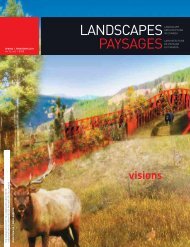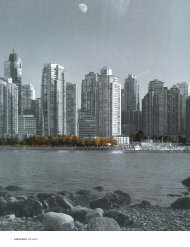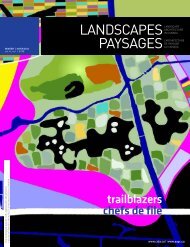time + place temps + lieu - CSLA :: AAPC
time + place temps + lieu - CSLA :: AAPC
time + place temps + lieu - CSLA :: AAPC
Create successful ePaper yourself
Turn your PDF publications into a flip-book with our unique Google optimized e-Paper software.
3<br />
Stanley Thompson worked on 121 golf courses in<br />
9 provinces…| Stanley Thompson a travaillé sur<br />
121 terrains de golf dans 9 provinces…<br />
The expectations become dangerous when<br />
they lead to proposals for a maintenance<br />
strategy or renovation plan that is in conflict<br />
with the original course design– or indeed,<br />
unattainable, if the design intent is to be<br />
respected. Green speeds provide a perfect<br />
example. Greens on most modern golf<br />
courses are designed to tolerate super-fast<br />
green speeds quite easily, whereas greens on<br />
many historic courses were designed to be<br />
much slower and featured steeper pitches<br />
and much more whimsical contouring.<br />
CONTEMPORARY PLAY ON<br />
A CLASSIC COURSE<br />
Finding a balance between the seemingly<br />
conflicting priorities of heritage conservation<br />
and contemporary play is often a matter<br />
of managing player expectations. Member<br />
education is essential. When members<br />
recognize that the golf course is a heritage<br />
landscape, valuable to the community and<br />
to the greater portfolio of heritage work,<br />
their expectations often shift. They are more<br />
willing to compromise, and often develop<br />
pride in this historical asset.<br />
Detailed information about course design<br />
is also key. An inventory which identifies all<br />
character-defining features of the original<br />
design and then evaluates their current<br />
condition will provide a baseline that can<br />
underpin future renovation planning. A<br />
knowledgeable golf course architect is<br />
invaluable – one who will make every effort to<br />
conserve the integrity of the original design.<br />
This requires an in-depth knowledge of the<br />
original designer’s work and design principles.<br />
RESTORING CLASSIC COURSES<br />
Support for protecting or restoring classic<br />
golf courses may not yet be the norm, but<br />
according to Bill Newton, Executive Director<br />
of the Stanley Thompson Society, “many<br />
existing classic clubs are experiencing a<br />
rejuvenation of their memberships as golfers<br />
have re-discovered the older courses of the<br />
twenties and thirties. Appropriate length,<br />
degrees of challenge, mature landscapes,<br />
better social interaction, comfortable<br />
spousal and senior play, all lead to a more<br />
enjoyable experience on the so-called<br />
‘classic’ courses.”<br />
Golf course architect Ian Andrew is one<br />
of several Canadians focused on restoration<br />
of Canada’s heritage courses. Educated<br />
at the University of Guelph in landscape<br />
architecture, Ian has been immersed in the<br />
history of golf course design and the works<br />
of the Golden Age masters since he was<br />
a teenager. In the mid-1990s, he became<br />
actively involved in promoting renovation<br />
of classic golf courses because, in his words,<br />
“I saw too many classic courses being<br />
insensitively altered.” In recent years his<br />
4<br />
3 PRACTICE ROUND, CANADIAN OPEN : THE 1ST FAIRWAY 4 + 5 HIGHLANDS LINKS IN CAPE BRETON<br />
HIGHLANDS NATIONAL PARK | 3 SÉANCE DE PRATIQUE SUR LA 1RE ALLÉE, OMNIUM CANADIEN<br />
4 + 5 HIGHLAND LINKS AU PARC NATIONAL DES HAUTES-TERRES-DU-CAP-BRETON<br />
PHOTOS 3 GOLF CANADA ARCHIVES/ ARCHIVES DE GOLF CANADA # 30699 4 + 5 PARKS CANADA/ PARCS CANADA/CHRIS GALLOW<br />
5<br />
26 LANDSCAPES PAYSAGES






